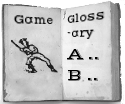Straight Town: Difference between revisions
No edit summary |
No edit summary |
||
| Line 5: | Line 5: | ||
|Game Eras=1800s | |Game Eras=1800s | ||
|Invented Game=No | |Invented Game=No | ||
|Description=As of mid-2023, we have only two (late 1800s] mentions of Straight Ball. It is described as a variant of Round Town, for which the four bases are lain out in a straight line, rather than as a circuit. Left unsettled is the matter whether advancing to the outmost base results in the scoring of a run. | |Description=<p>As of mid-2023, we have only two (late 1800s] mentions of Straight Ball. It is described as a variant of Round Town, for which the four bases are lain out in a straight line, rather than as a circuit. Left unsettled is the matter whether advancing to the outmost base results in the scoring of a run. </p> | ||
|Sources=Email from Bill Hicklin, February 2016:<p>". . . Bill Hicklin adds: | |Sources=<p>Email from Bill Hicklin, February 2016:</p> | ||
<p>". . . Bill Hicklin adds:</p> | |||
<p>I found two references to Virginia 'round-town',<strong> </strong>both from Dickinson County, Virginia (in the Appalachian coal country). They come from<em> School and Community History of Dickenson County, Virginia</em> (ed. Dennis Reedy), a compilation of articles published over many years in the local paper, which were themselves based on a series of oral-history interviews conducted at the behest of the school superintendent with senior and retired Dickenson teachers.</p> | |||
<p> [1] William Ayers Dyer: "I was born May 10, 1880 at Stratton, Dickenson County, Virginia and started to school to Johnson Skeen at the Buffalo School in 1885 when I was 5 years old... The games we played at the Buffalo were '''straight town''', round town, base, bull pen and antnee over." (Bull pen was dodgeball, but played with a baseball. Ouch!)</p> | |||
<p> [2]Hampton Osborne (b. 1894):'Round-town' and ''''straight-town' '''were popular games. Round-town had four bases in a circle, as baseball does today. If the batter was caught or crossed-off both ways, he was out. '''Straight-town''' had four bases in a row and you used the same rules as round-town."</p> | |||
|Has Supplemental Text=No | |Has Supplemental Text=No | ||
}} | }} | ||
Revision as of 08:09, 31 May 2023
| Game | Straight Town |
|---|---|
| Game Family | Baseball |
| Location | |
| Regions | US |
| Eras | 1800s |
| Invented | No |
| Tags | |
| Description | As of mid-2023, we have only two (late 1800s] mentions of Straight Ball. It is described as a variant of Round Town, for which the four bases are lain out in a straight line, rather than as a circuit. Left unsettled is the matter whether advancing to the outmost base results in the scoring of a run. |
| Sources | Email from Bill Hicklin, February 2016: ". . . Bill Hicklin adds: I found two references to Virginia 'round-town', both from Dickinson County, Virginia (in the Appalachian coal country). They come from School and Community History of Dickenson County, Virginia (ed. Dennis Reedy), a compilation of articles published over many years in the local paper, which were themselves based on a series of oral-history interviews conducted at the behest of the school superintendent with senior and retired Dickenson teachers. [1] William Ayers Dyer: "I was born May 10, 1880 at Stratton, Dickenson County, Virginia and started to school to Johnson Skeen at the Buffalo School in 1885 when I was 5 years old... The games we played at the Buffalo were straight town, round town, base, bull pen and antnee over." (Bull pen was dodgeball, but played with a baseball. Ouch!) [2]Hampton Osborne (b. 1894):'Round-town' and 'straight-town' were popular games. Round-town had four bases in a circle, as baseball does today. If the batter was caught or crossed-off both ways, he was out. Straight-town had four bases in a row and you used the same rules as round-town." |
| Source Image | [[Image:|left|thumb]] |
| Comment | Edit with form to add a comment |
| Query | Edit with form to add a query |
| Has Supplemental Text |
Comments
<comments voting="Plus" />
